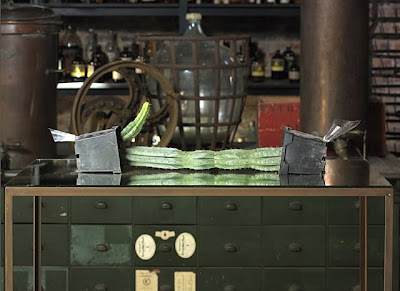I recently got in contact with the German artist Klaus Weber who works with cacti (among other things) in an artistic context.

Double Cactus by Klaus Weber
Klaus would like to exhibit a Double Cactus in New York, i.e. a piece consisting of two San Pedro (Trichocereus pachanoi) plants grafted together to form one, mirrored plant similar to the ones pictured in this post. Unfortunately Klaus has encountered problems with bringing the plant(s) into the US from Germany and consequently he is looking for a US resident who can help him recreate the grafted cactus piece “in situ”. If you (or anybody you know) are a skilled grafter with the inclination to collaborate with Klaus on creating a Double Cactus in the states, please get in touch with me.

Another Double Cactus
I'm especially infatuated with the last picture – the cacti that sort of grow into each other, reflected in the mirror they sit on, go perfectly with the pillar that transcends smoothly from the “actual” world into the reality behind the looking glass.
The pictures are used with the kind permission of Klaus Weber.
Tuesday, January 05, 2010
Cactus art: Double Cactus / Doppelkaktus
Saturday, January 02, 2010
The Lophophora blog turns 5
Five years ago today, this blog started out with a humble test post. 
The blog was started in frustration over the limited amount of meaningful information about Lophophora online. It was originally conceived as a Lophophora/peyote only blog, but early on (beginning with the first post, one could argue ;-) the blog segued into a more general cactus blog, covering especially smaller Mexican species. Lately a few pieces of non-cactus related flotsam and jetsam have also drifted onto the blog, but the main focus will not swerve from cacti in general and the Lophophora genus specifically.
I hope the blog has met its objectives and provided the reader with (at least a few bits of ;-) relevant information on the Lophophora genus.
Seeing the initial test post again reminds me that I have loads of pictures from my visit to the Joshua Tree National Park that I would like to share – maybe in a future post ;-)
All Time Most Popular Posts
-
Lophophora williamsii (peyote) populations have diminished in large areas of South Texas where peyoteros harvest the cactus for ceremonial ...
-
On various occasions I've been asked what growing media I'm using for my cactus plants. I don't have a set soil mix recipe as su...
-
Below is a list of retailers/nurseries selling cactus seed and plants. I've only listed vendors I've done business with. If you ar...
-
Most cacti are easily grown from seed - and with a little patience and care they can be grown into beautiful plants. Lophophora williamsi...
-
In last month’s post on the troubled Texan peyoteros I referred to Anderson’s article on the peyote situation in Texas. Given the importanc...
-
Yet another slightly off topic and probably not entirely politically correct post, but I couldn’t help noticing the similarity of my monstr...
-
Flowering stand of San Pedro cacti (Trichocereus pachanoi) To me the main draw of the San Pedro cactus ( Trichocereus pachanoi (syn. Ech...
-
In the June 2008 issue of the Cactus & Co magazine Jaroslav Šnicer, Jaroslav Bohata, and Vojtěch Myšák described a new Lophophora spec...
-
There seems to be an increased focus on the alarming Texas peyote situation. A couple of weeks ago the Houston Press published a mournful, i...
-
I spent two weeks working in Delhi, India during January. I had one weekend off and had planned to spend it in Delhi at my own leisure, but ...


















